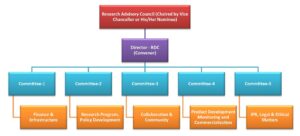Research and Development Cell
Introduction
The National Education Policy (NEP) 2020 envisages the promotion of quality research within the Higher Education system. Research and innovation are important aspects to enhance quality education by the Higher Education Institutions (HEIs). Societal challenges of our country can only be addressed by having a strong and vibrant higher education ecosystem with an emphasis on research, innovation, and technology development. The integration of Research, Innovation and Technology Development is the foundation of Atma-Nirbhar Bharat (Self-reliant India). The establishment of Research and Development Cell (RDC) in HEIs will enable attainment of targets of Atma-Nirbhar Bharat and is expected to play a pivotal role in catalyzing multidisciplinary/transdisciplinary and translational research culture mandated in NEP 2020.
Vision
To put in place a robust mechanism for developing and strengthening the research ecosystem within HEIs, aligned with the provisions of NEP-2020.
Mission
- To create a conducive environment for enhanced research productivity.
- To encourage collaboration across industry, government, community- based organizations, and agencies at the local, national, and international levels.
- To facilitate greater access to research through mobilization of resources and funding.
Objectives
- To create an organizational structure with role-based functions of RDC, formulate Research Policy for the HEIs, identify thrust areas of research, and form related cluster groups/frontline teams/consortia of researchers.
- To create enabling provisions in Research Policies for recruitment of research personnel, procurement of equipment, and financial management with adequate autonomy to the Principal Investigator(s) and disseminate research outcomes to stakeholders and the public at large.
- To establish a special purpose vehicle to promote researchers and innovators, identify potential collaborators from industry, research organizations, academic institutions & other stakeholders for cooperation and synergistic partnerships.
- To act as a liaison between researchers & relevant research funding agencies, extend guidance in preparation & submission of project proposals and post-sanctioning of the grants to oversee adherence to timelines.
- To have better coordination among other cells/centers dealing with University-Industry Inter Linkage, Incubation, Innovation and Entrepreneurship Development and Intellectual Property Rights (IPR).
- To develop an Institutional Research Information System for sharing the status of ongoing/completed research projects/Programmes, expertise & resources, etc., making effective use of Information & Communication Technology (ICT) for preparing the database of in-house experts to provide industrial consultancy and services.
- To engage & utilize the services of superannuated active faculty/scientists in research capacity building of talented young minds and promote mobility of researchers across institutions and R&D Labs.
- To serve as nodal center for ideation and conceptualization of research topics/themes by organizing workshops and training programs and ensuring the integrity and ethical practices in research activities including clearance of bioethical committee wherever required.
Functions
The UGC launched an initiative to establish a RDC in HEIs with the mandate for promoting quality research that contributes meaningfully towards the goal of a self-reliant India (“Atma-Nirbhar Bharat”), aligned with the provisions of NEP-2020.
The RDC would help creating a research ecosystem for reliable, impactful, and sustained research output. The essential elements of such an ecosystem, viz., generation of knowledge and facilitation of research, innovation and technology development for industrial & societal benefits, are addressed by human resource (researcher & faculty), intellectual capital (knowledge & skills), governance (regulation & policies) and financial resources (funding & grants).
Governance
An efficient governance mechanism, which ensures functional autonomy, transparency, accountability, adaptability by strengthening interlinkages to create a conducive research environment.
The HEIs can foster the human elements (faculty, staff, scholars, and students), logistics (land, buildings, and facilities), knowledge resources (research equipment, project utilities, and consumables), fund flow, etc. through a steady, proficient, effective governance (Rules, Norms, and Policies) and financial (Grants and Funds) management. Dedicated leadership and administrative structure for research, led by experienced researchers, are essential for establishing an effective and robust Research Governance in RDC at HEIs.
The Research Governance will have a Research Advisory Council (RAC) headed by the Vice-Chancellor/Principal or his/her nominee as the apex body of RDC. The Director, nominated by Vice-Chancellor among the distinguished researchers from the university, will head various committees to drive the governance. RDC may form multiple committees to smoothen its functioning with respective committee members nominated by the Director
– RDC and approved by RAC. The organisational structure of RDC comprising of various
committeees for specifified functions may be as under:

Research Ecosystem/Collaboration
A vibrant research ecosystem in HEI aims to provide meaningful thrust for sustainable research and innovation and promote collaboration between government, universities, research institutes and industries.
HEIs need to build a sustainable research ecosystem that leads to consistent quality research outcomes and enhanced productivity. In order to make RDC functionality viable, the HEIs that are relatively new or not so well established should develop a connection with RDCs of already well-known/established HEIs for their research.
RDC in each HEI will act as a facilitator for networking and collaborative research with other national and international institutions working in inter- disciplinary, trans-disciplinary, and multidisciplinary research areas. Reformed administrative structure at HEIs can reach out to key industry players, research organizations, institutions, associations, NGOs, government bodies to forge strategic partnerships.
HEIs need to establish collaborations, teams/consortia, partnerships, and combined ventures for joint research activities through clustering institutions and organizations to facilitate the exchange of students, scholars, and faculty.
There is a need to strengthen resource sharing in content and infrastructure both within the university and among universities, funding agencies, industries, corporates and government.
Research Promotion & Guidance
Research promotion activities at the HEI should be aligned with the mandates of various National Missions, SDGs, Start-up India leading to a Self-Reliant India (Atma-Nirbhar Bharat).
Research Guidance from RDC will aim to encourage faculties to conceive ideas through enhanced industry-academia interactions and prepare research proposals for funding from various agencies. Organizing events like capacity- building programs (Research 8 Methodology and Research Techniques) and specific research theme-based workshops and Research Internships will motivate the end-users (students, scholars, and faculties) to participate actively in the process of ideation and innovative research in emerging areas.

